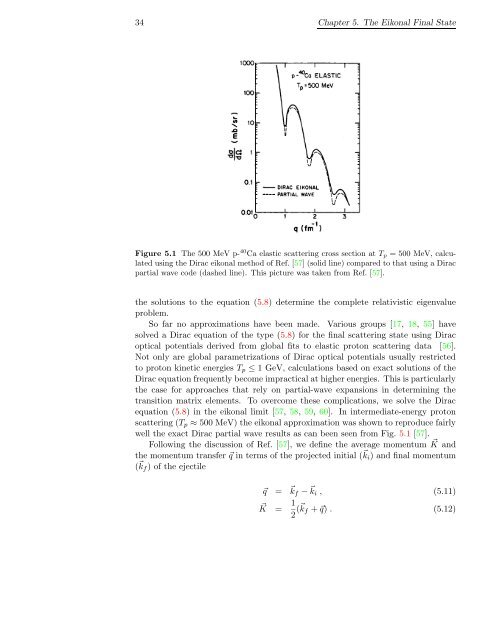Download Thesis in Pdf Format - Theoretical Nuclear Physics and ...
Download Thesis in Pdf Format - Theoretical Nuclear Physics and ...
Download Thesis in Pdf Format - Theoretical Nuclear Physics and ...
You also want an ePaper? Increase the reach of your titles
YUMPU automatically turns print PDFs into web optimized ePapers that Google loves.
34 Chapter 5. The Eikonal F<strong>in</strong>al State<br />
Figure 5.1 The 500 MeV p- 40 Ca elastic scatter<strong>in</strong>g cross section at T p = 500 MeV, calculated<br />
us<strong>in</strong>g the Dirac eikonal method of Ref. [57] (solid l<strong>in</strong>e) compared to that us<strong>in</strong>g a Dirac<br />
partial wave code (dashed l<strong>in</strong>e). This picture was taken from Ref. [57].<br />
the solutions to the equation (5.8) determ<strong>in</strong>e the complete relativistic eigenvalue<br />
problem.<br />
So far no approximations have been made. Various groups [17, 18, 55] have<br />
solved a Dirac equation of the type (5.8) for the f<strong>in</strong>al scatter<strong>in</strong>g state us<strong>in</strong>g Dirac<br />
optical potentials derived from global fits to elastic proton scatter<strong>in</strong>g data [56].<br />
Not only are global parametrizations of Dirac optical potentials usually restricted<br />
to proton k<strong>in</strong>etic energies T p ≤ 1 GeV, calculations based on exact solutions of the<br />
Dirac equation frequently become impractical at higher energies. This is particularly<br />
the case for approaches that rely on partial-wave expansions <strong>in</strong> determ<strong>in</strong><strong>in</strong>g the<br />
transition matrix elements. To overcome these complications, we solve the Dirac<br />
equation (5.8) <strong>in</strong> the eikonal limit [57, 58, 59, 60]. In <strong>in</strong>termediate-energy proton<br />
scatter<strong>in</strong>g (T p ≈ 500 MeV) the eikonal approximation was shown to reproduce fairly<br />
well the exact Dirac partial wave results as can been seen from Fig. 5.1 [57].<br />
Follow<strong>in</strong>g the discussion of Ref. [57], we def<strong>in</strong>e the average momentum K ⃗ <strong>and</strong><br />
the momentum transfer ⃗q <strong>in</strong> terms of the projected <strong>in</strong>itial ( ⃗ k i ) <strong>and</strong> f<strong>in</strong>al momentum<br />
( ⃗ k f ) of the ejectile<br />
⃗q = ⃗ k f − ⃗ k i , (5.11)<br />
⃗K = 1 2 (⃗ k f + ⃗q) . (5.12)















